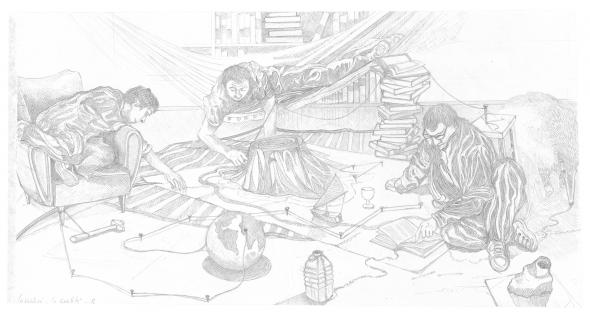Right After the Comma
In the winter of 2010, besides working on the project Right After the Comma, I wrote The Treatise of the Breathless Well1. Because the idea was to write an abyssological text, I borrowed the abyssal structure from Dante’s Inferno: a cone-shaped well which descends to the centre of the earth divided into steps that get progressively smaller the closer they get to the bottom. Some of these steps are divided into Giron, a kind of cylindrical segment where sins of every shade are dealt with in the most convenient manner. The main body of the text in The Treatise of the Breathless Well is the well itself, which ends with the disappearance of one of the characters in a glass of water, in the letter “O” of “H2O”, to be more exact. The successive circles that ring hell are the footnotes and the Girons the meta-notes (notes about notes) and meta-meta-notes (notes about notes about notes). This is a text that branches out from the centre to the edges and every word chosen spawns another text and other possible directions. This, then, is what I propose.
The main text is a chronicle, a story which exposes the facts in simple narrative form and according to the order in which they happened. It is, at the same time, a hypomnemata2: a Greek term referring to memory aids like notebooks, public records or personal notes. To this text, which thus unfolds, I added footnotes3, commentaries and more specific texts on various themes that are like trunks, lianas, epyphytes, branches, shortcuts, paths and bifurcations with which I crowd4 the body of the text, but in the opposite sense: inside out. Alongside these writings of a plant-like morphology, I have also added the story of Hony, the drawer of circles, a fictional character who has accompanied me for some time already and who replaces me in the drawings like a double. Inspired by the desert, these texts will enclose all of the rest. All that’s missing is to know where the islands fit in, whose advantage lies in the fact that they need no sustenance and that their only link to the archipelagos and mainlands is via the tenuous thread of migratory birds, fish and the currents. These paths, like perspective lines, appeared in the alleyways of days, in chance readings, and little by little formed an entire landscape, an archipelago of deserted and solitary islands – the place where:
“[…] it is not creation but re-creation, not the beginning but a re-beginning that takes place. The deserted island is the origin, but a second origin. From it everything begins anew.5”
 Mattia Denisse, 2011. Graphite on paper.
Mattia Denisse, 2011. Graphite on paper.
- 1. As yet unpublished. Commissioned by the International Abyssological Society.
- 2. Foucault described it as writing about oneself as a means of self-creation.
- 3. And head notes (canopy notes)
- 4. This expression is borrowed from Montaigne, who, in the chapter “That to study philosophy is to learn to die” in essays, refers to the “crowding” of his quotations: “… it is manifest enough, by my crowding in examples of this kind ….” Montaigne, Michel de. The Complete essays of Michel de Montaigne (1580). 1877, Book i, Chapter xix. Project Gutenberg ebook. www.gutenberg.org/files/3600/3600-h/3600-h.html. Translated by Charles Cotton.
- 5. Deleuze, Gilles. “Desert Islands”, desert islands and Other Texts 1953-1974. London, Semiotext(e) Foreign Agents Series, 2004, p. 12. Translated by Mike Taormina.